1994 CHEVROLET BLAZER power steering
[x] Cancel search: power steeringPage 166 of 348
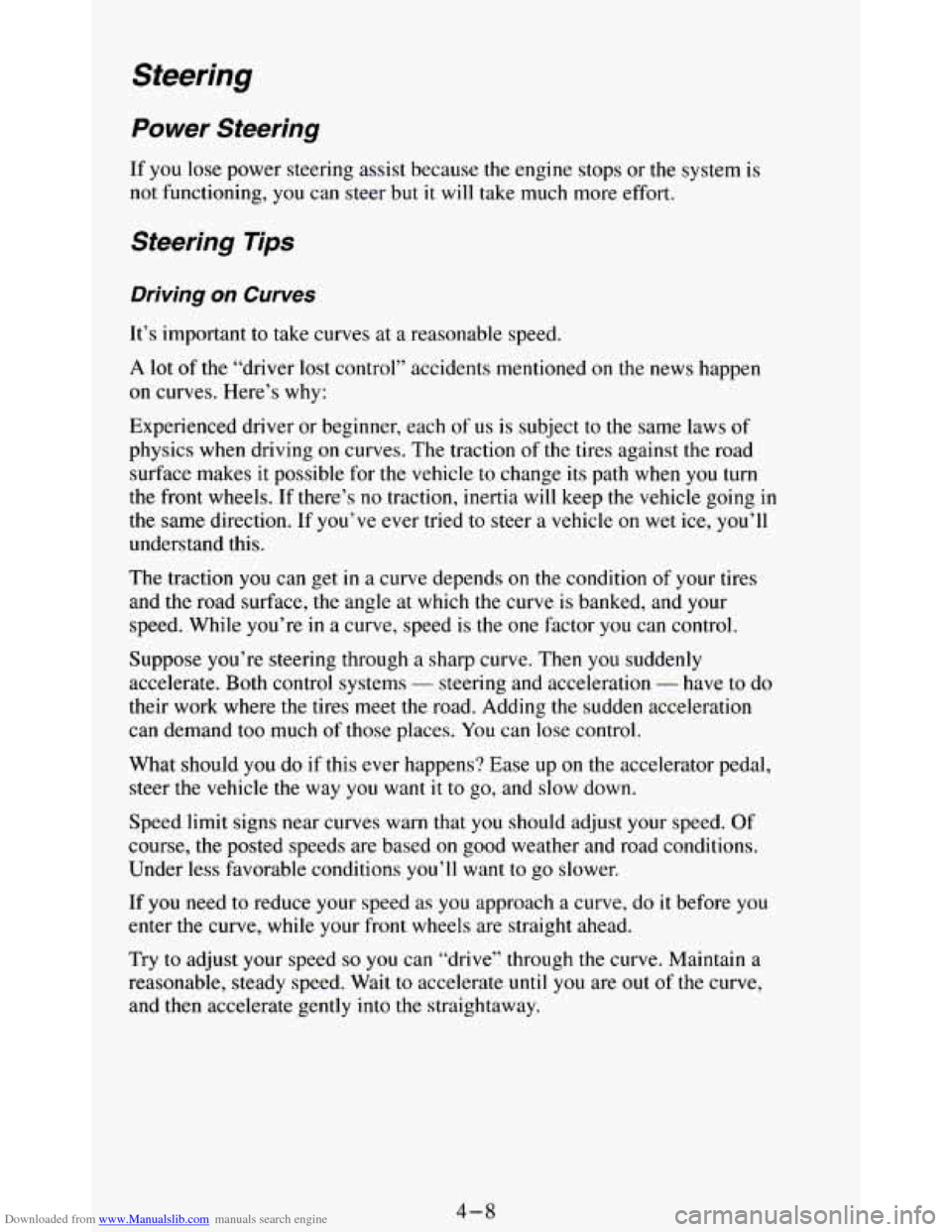
Downloaded from www.Manualslib.com manuals search engine Power Steering
If you lose power steering assist because the engine stops or the system is
not functioning, you can steer but it will take much more effort.
Steering Tips
Driving on Curves
It’s important to take curves at a reasonable speed.
A lot
of the “driver lost control” accidents mentioned on the news happen
on curves. Here’s why:
Experienced driver or beginner, each
of us is subject to the same laws of
physics when driving on curves. The traction of the tires against the road
surface makes it possible for the vehicle to change its path when you turn
the front wheels. If there’s
no traction, inertia will keep the vehicle going in
the same direction. If you’ve ever tried to steer
a vehicle on wet ice, you’ll
understand this.
The traction you can get in a curve depends on the condition of your tires
and the road surface, the angle at which the curve
is banked, and your
speed. While you’re
in a curve, speed is the one factor you can control.
Suppose you’re steering through a sharp curve. Then
you suddenly
accelerate. Both control systems
- steering and acceleration - have to do
their work where the tires meet the road. Adding the sudden acceleration
can demand too much
of those places. You can lose control,
What should you do
if this ever happens? Ease up on the accelerator pedal,
steer
the vehicle the way you want it to go, and slow down.
Speed limit signs near curves warn that
you should adjust your speed. Of
course, the posted speeds are based
on good weather and road conditions.
Under less favorable conditions you’ll want
to go slower.
If you need to reduce your speed as you approach a curve, do it before you
enter the curve, while your front wheels are straight ahead.
Try
to adjust your speed so you can “drive” through the curve. Maintain a
reasonable, steady speed. Wait to accelerate until you are out of the curve,
and then accelerate gently into
the straightaway.
4-8
Page 175 of 348
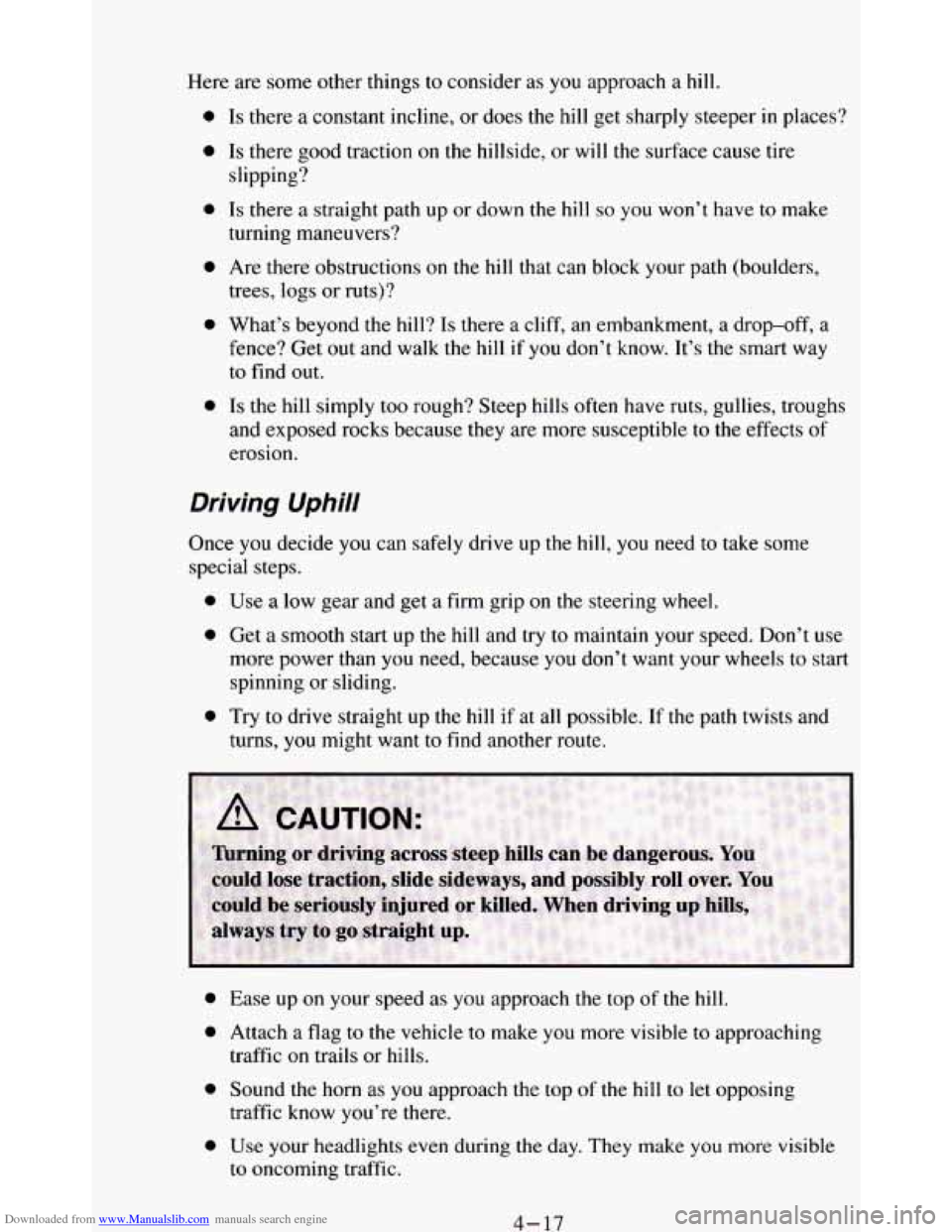
Downloaded from www.Manualslib.com manuals search engine Here are some other things to consider as you approach a hill.
0
0
0
0
0
0
Is there a constant incline, or does the hill get sharply steeper in places?
Is there good traction on the hillside, or will the surface cause tire
slipping?
Is there a straight path up or down the
hill so you won’t have to make
turning maneuvers?
Are there obstructions on
the hill that can block your path (boulders,
trees, logs or ruts)?
What’s beyond the hill?
Is there a cliff, an embankment, a drop-off, a
fence? Get out and walk the hill
if you don’t know. It’s the smart way
to find out.
Is the hill simply too rough? Steep hills often have ruts, gullies, troughs
and exposed rocks because they are more susceptible to the effects of
erosion.
Driving Uphill
Once you decide you can safely drive up the hill, you need to take Some
special steps.
0
0
0
Use a low gear and get a firm grip on the steering wheel.
Get a smooth start up the hill and try
to maintain your speed. Don’t use
more power
than you need, because you don’t want your wheels to start
spinning or sliding.
Try to drive straight up the hill
if at all possible. If the path twists and
turns, you might want to find another route.
0
0
0
0
Ease up on your speed as you approach the top of the hill.
Attach a flag to the vehicle to make you more visible to approaching
traffic on trails or hills.
Sound the horn
as you approach the top of the hill to let opposing
traffic know you’re there.
Use your headlights even during the day. They make you more visible
to oncoming traffic.
4- 17
Page 237 of 348
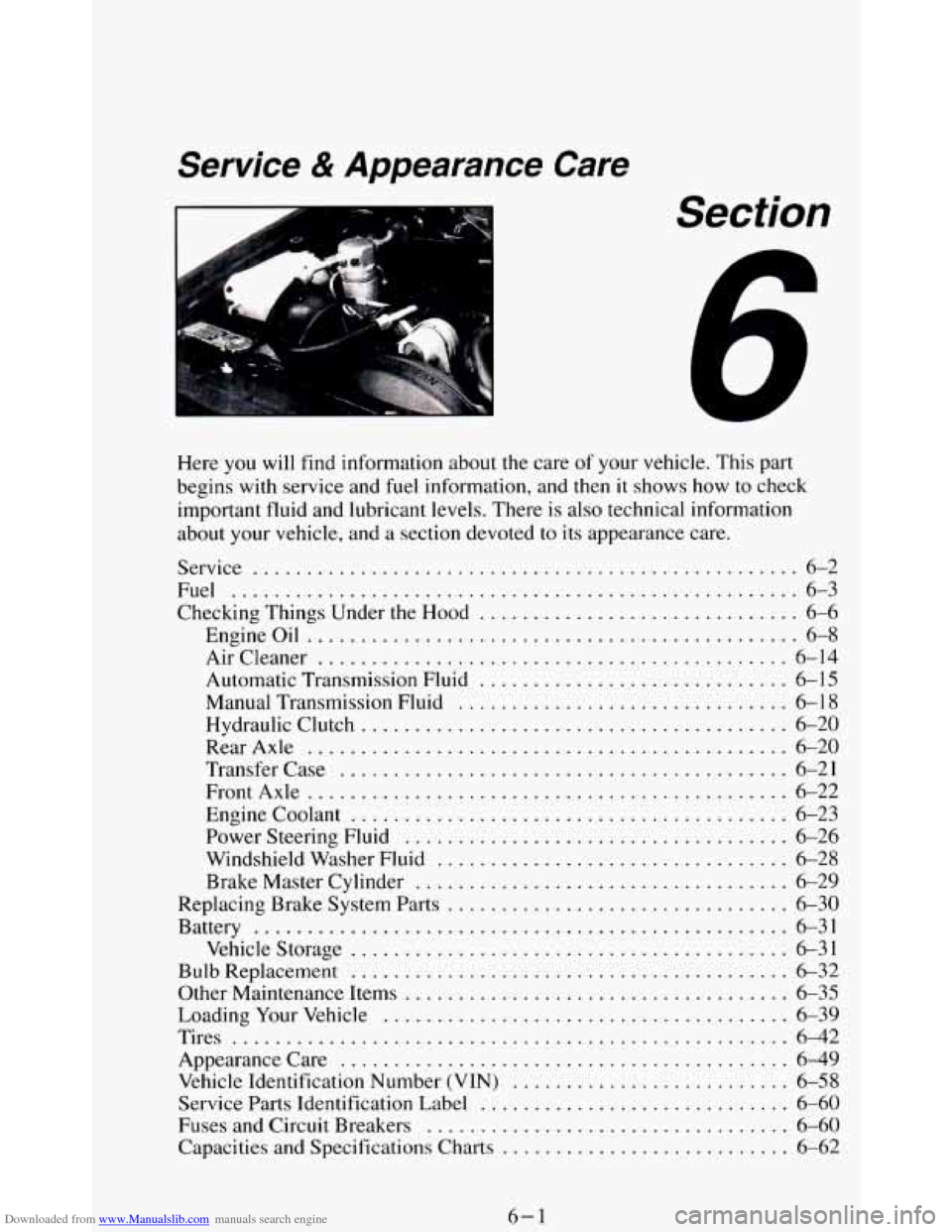
Downloaded from www.Manualslib.com manuals search engine Service & Appearance Care
Section
Here you will find information about the care of your vehicle . This part
begins with service and fuel information. and then
it shows how to check
important fluid and lubricant levels
. There is also technical information
about your vehicle. and a section devoted to
its appearance care .
Service ................................................... 6-2
Fuel
..................................................... 6-3
Checking Things Under the Hood
.............................. 6-6
Engineoil
.............................................. 6-8
Aircleaner
............................................ 6-14
Automatic Transmission Fluid
............................. 6-15
Manual Transmission Fluid
............................... 6-18
Hydraulic Clutch ........................................ 6-20
RearAxle
............................................. 6-20
Transfer Case
.......................................... 6-21
FrontAxle
............................................. 6-22
Enginecoolant
......................................... 6-23
Power Steering Fluid
.................................... 6-26
Windshield Washer Fluid
................................. 6-28
Brake Master Cylinder
................................... 6-29
Replacing Brake System Parts
................................ 6-30
Battery
.................................................. 6-31
Vehiclestorage
......................................... 6-31
Bulb Replacement
......................................... 6-32
Other Maintenance Items
.................................... 6-35
Loading Your Vehicle
...................................... 6-39
Tires .................................................... 6-42
Appearance Care
.......................................... 6-49
Vehicle Identification Number (VIN)
.......................... 6-58
Service Parts Identification Label
............................. 6-60
Fuses and Circuit Breakers
.................................. 6-60
Capacities and Specifications Charts
........................... 6-62
6-1
Page 262 of 348
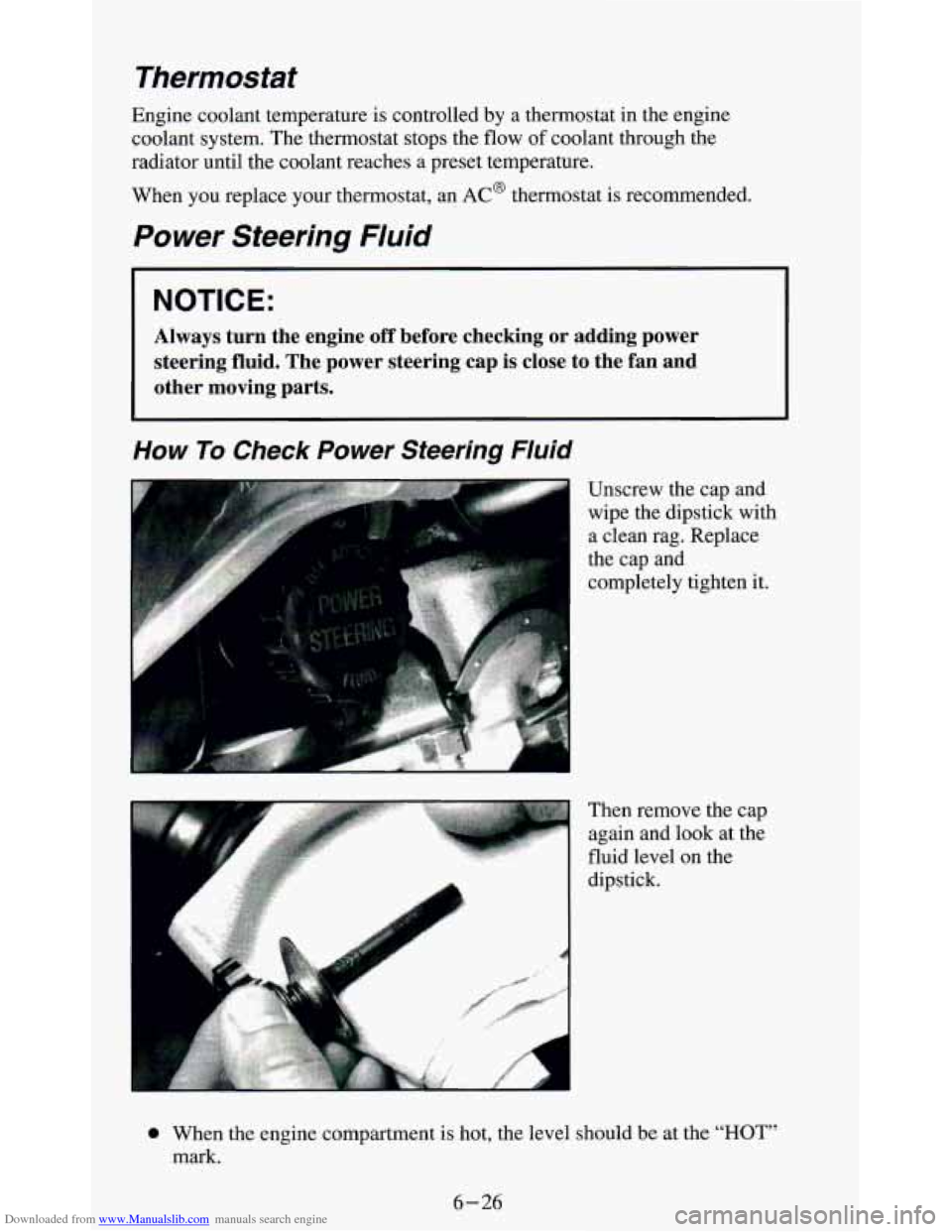
Downloaded from www.Manualslib.com manuals search engine Thermostat
Engine coolant temperature is controlled by a thermostat in the engine
coolant system. The thermostat stops the flow
of coolant through the
radiator until the coolant reaches
a preset temperature.
When you replace your thermostat, an
AC@ thermostat is recommended.
Power Steering Fluid
NOTICE:
Always turn the engine off before checking or adding power
steering fluid. The power steering cap is close to the fan and
other moving parts.
P
i
Unscrew the cap and
wipe the dipstick with
a clean rag. Replace
the cap and
completely tighten it.
Then remove the cap
again and look at the
fluid level on the
dipstick.
0 When the engine compartment is hot, the level should be at the “HOT”
mark.
6-26
Page 263 of 348
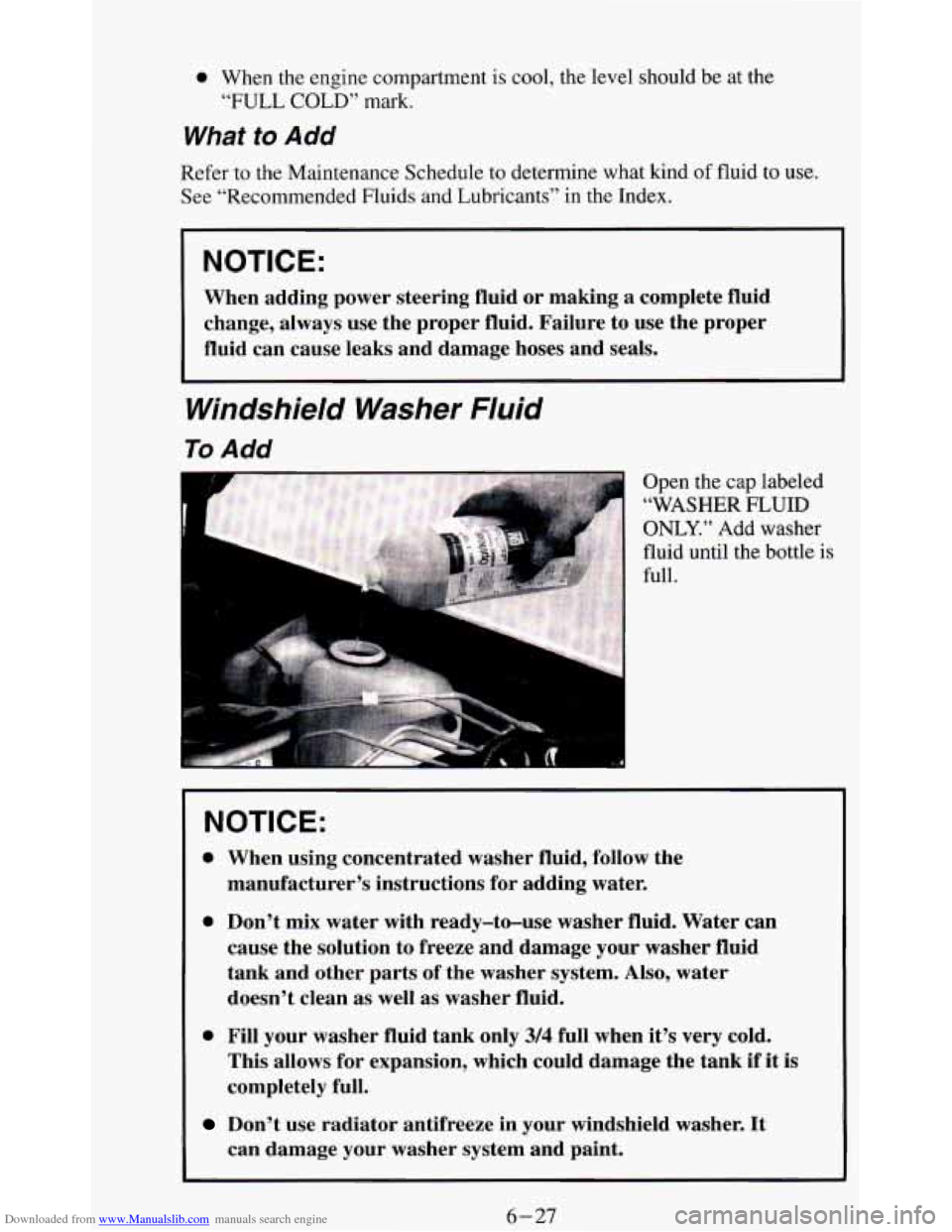
Downloaded from www.Manualslib.com manuals search engine 0 When the engine compartment is cool, the level should be at the
“FULL COLD” mark.
What to Add
Refer to the Maintenance Schedule to determine what kind of fluid to use.
See “Recommended Fluids and Lubricants”
in the Index.
NOTICE:
When adding power steering fluid or making a complete fluid
change, always use the proper fluid. Failure to use the proper
fluid can cause leaks and damage hoses and seals.
Windshield Washer Fluid
To Add
Open the cap labeled
“WASHER FLUID
ONLY.” Add washer
fluid until the
bottle is
full.
NOTICE:
0 When using concentrated washer fluid, follow the
manufacturer’s instructions for adding water.
0 Don’t mix water with ready-to-use washer fluid, Water can
cause the solution to freeze and damage your washer fluid
tank and other parts of the washer system.
Also, water
doesn’t clean as well as washer fluid.
0 Fill your washer fluid tank only 3/4 full when it’s very cold.
This allows for expansion, which could damage the tank if it
is
completely full.
Don’t use radiator antifreeze in your windshield washer. It
can damage your washer system and paint,
6-27
Page 318 of 348
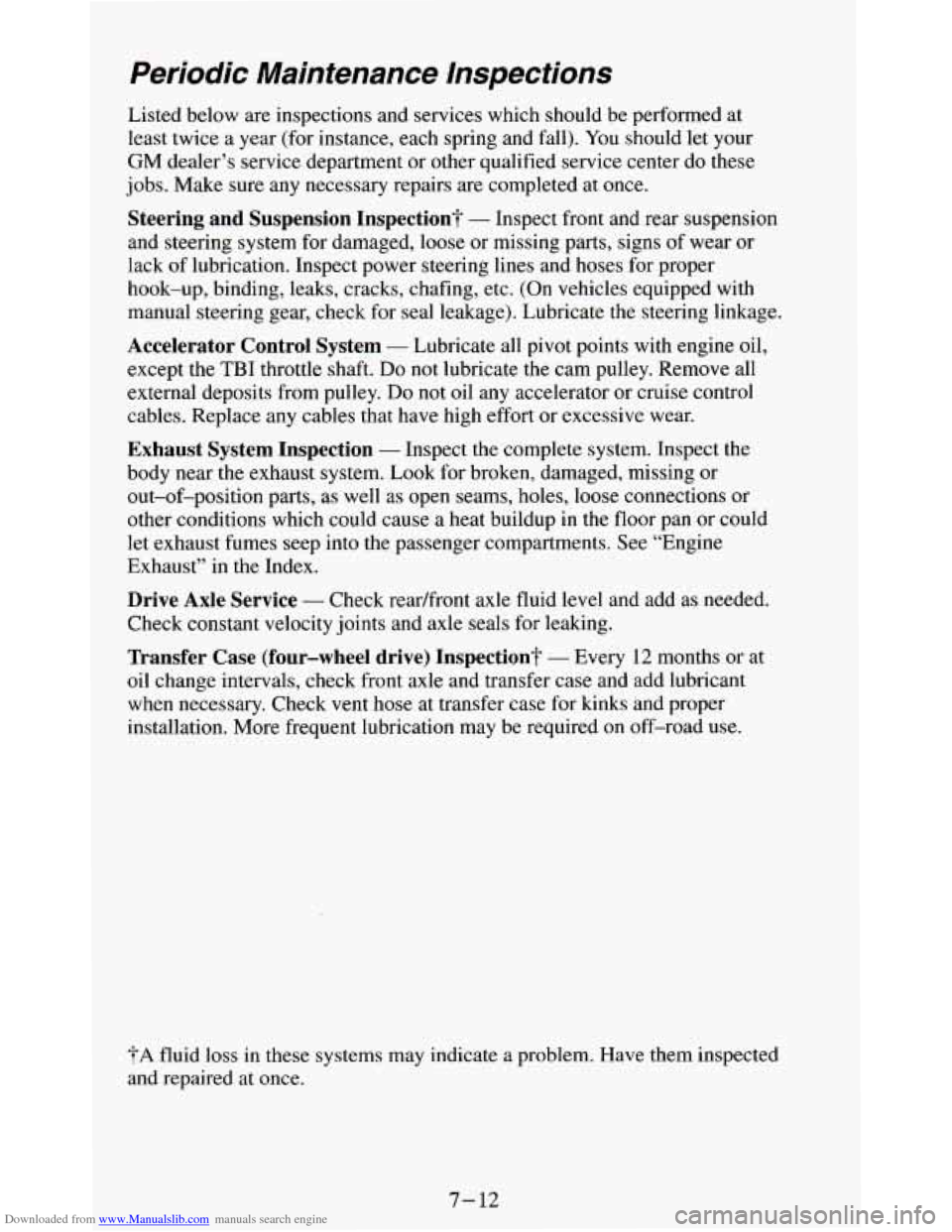
Downloaded from www.Manualslib.com manuals search engine Periodic Maintenance Inspections
Listed below are inspections and services which should be performed at
least twice a year (for instance, each spring and fall). You should let your
GM dealer’s service department or other qualified service center do these
jobs. Make sure any necessary repairs are completed at once.
Steering and Suspension Inspection? - Inspect front and rear suspension
and steering system for damaged,
loose or missing parts, signs of wear or
lack of lubrication. Inspect power steering lines and hoses for proper
hook-up, binding, leaks, cracks, chafing, etc. (On vehicles equipped with
manual steering gear, check for seal leakage). Lubricate the steering linkage.
Accelerator Control System - Lubricate all pivot points with engine oil,
except the
TBI throttle shaft. Do not lubricate the cam pulley. Remove all
external deposits from pulley.
Do not oil any accelerator or cruise control
cables. Replace any cables that have high effort or excessive wear.
Exhaust System Inspection - Inspect the complete system. Inspect the
body near the exhaust system. Look for broken, damaged, missing or
out-of-position parts,
as well as open seams, holes, loose connections or
other conditions which could cause a heat buildup in the floor pan or could
let exhaust fumes seep into the passenger compartments. See “Engine
Exhaust” in the Index.
Drive Axle Service - Check readfront axle fluid level and add as needed.
Check constant velocity joints and axle seals for leaking.
Transfer Case (four-wheel drive) Inspection? - Every 12 months or at
oil change intervals, check front axle and transfer case and add lubricant
when necessary. Check vent hose at transfer case for kinks and proper
installation. More frequent lubrication may be required
on off-road use.
?A fluid loss in these systems may indicate a problem. Have them inspected
and repaired at once.
7- 12
Page 319 of 348
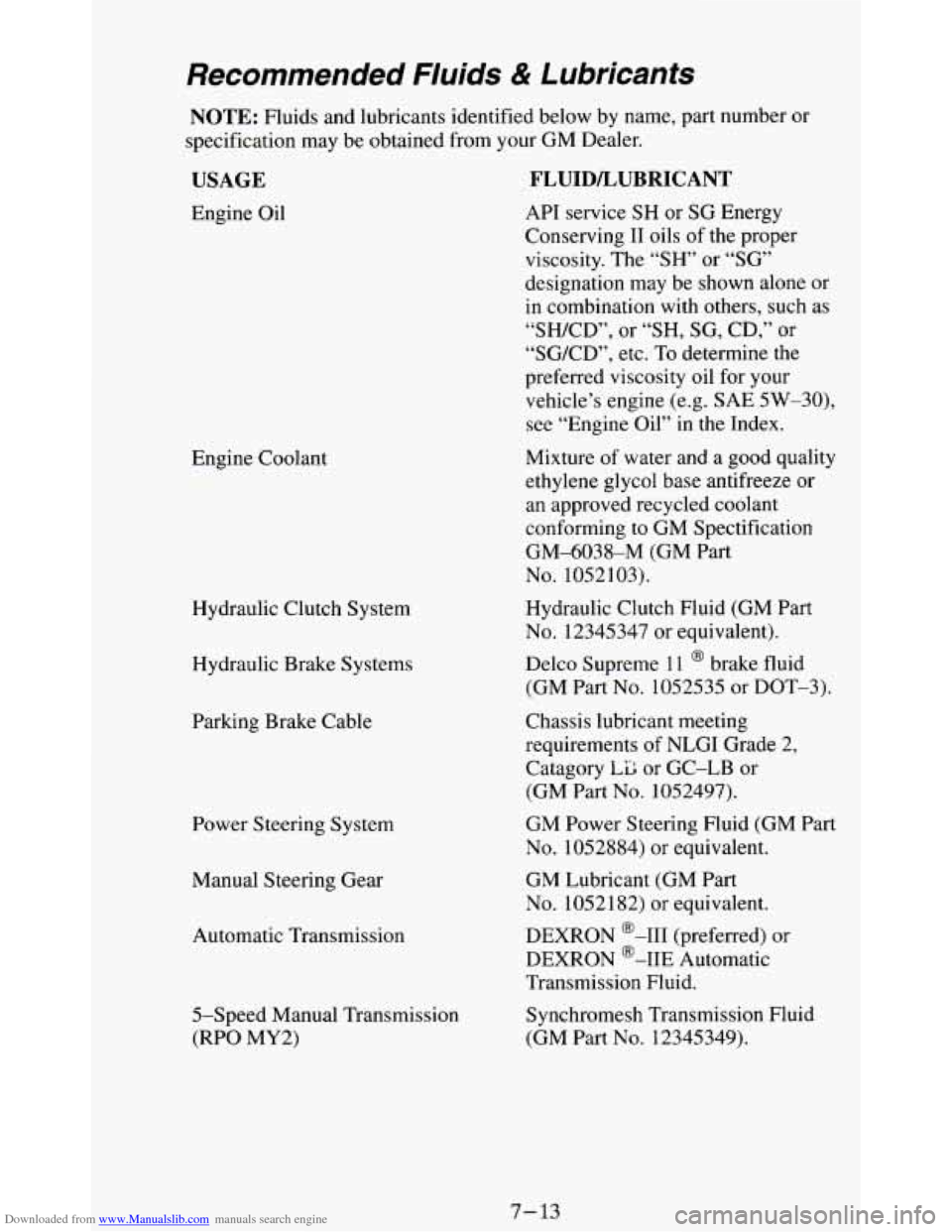
Downloaded from www.Manualslib.com manuals search engine Recommended Fluids & Lubricants
NOTE: Fluids and lubricants identified below by name, part number or
specification may be obtained from your GM Dealer.
USAGE
Engine Oil
Engine Coolant
Hydraulic Clutch System
Hydraulic Brake Systems
Parking Brake Cable Power Steering System
Manual Steering Gear
Automatic Transmission
5-Speed Manual Transmission
(RPO MY2)
FLUIDLUBRICANT
API service SH or SG Energy
Conserving
I1 oils of the proper
viscosity. The “SH” or
“SG’
designation may be shown alone or
in combination with others, such as
“SH/CD”, or “SH, SG, CD,”
or
“SG/CD”, etc. To determine the
preferred viscosity oil for your
vehicle’s engine (e.g.
SAE 5W-30),
see “Engine Oil”
in the Index.
Mixture of water and
a good quality
ethylene glycol base antifreeze or
an approved recycled coolant
conforming to GM Spectification
GM-6038-M (GM Part
No. 1052 103).
Hydraulic Clutch Fluid (GM Part
No. 12345347 or equivalent).
Delco Supreme
1 1 @ brake fluid
(GM Part No. 1052535 or DOT-3).
Chassis lubricant meeting
requirements
of NLGI Grade 2,
Catagory
LiIl or GC-LB or
(GM Part No. 1052497).
GM Power Steering Fluid (GM Part
No. 1052884) or equivalent.
GM Lubricant (GM Part
No. 1052182) or equivalent.
DEXRON
@-I11 (preferred) or
DEXRON @-IIE Automatic
Transmission Fluid.
Synchromesh Transmission Fluid
(GM Part
No. 12345349).
7- 13
Page 324 of 348
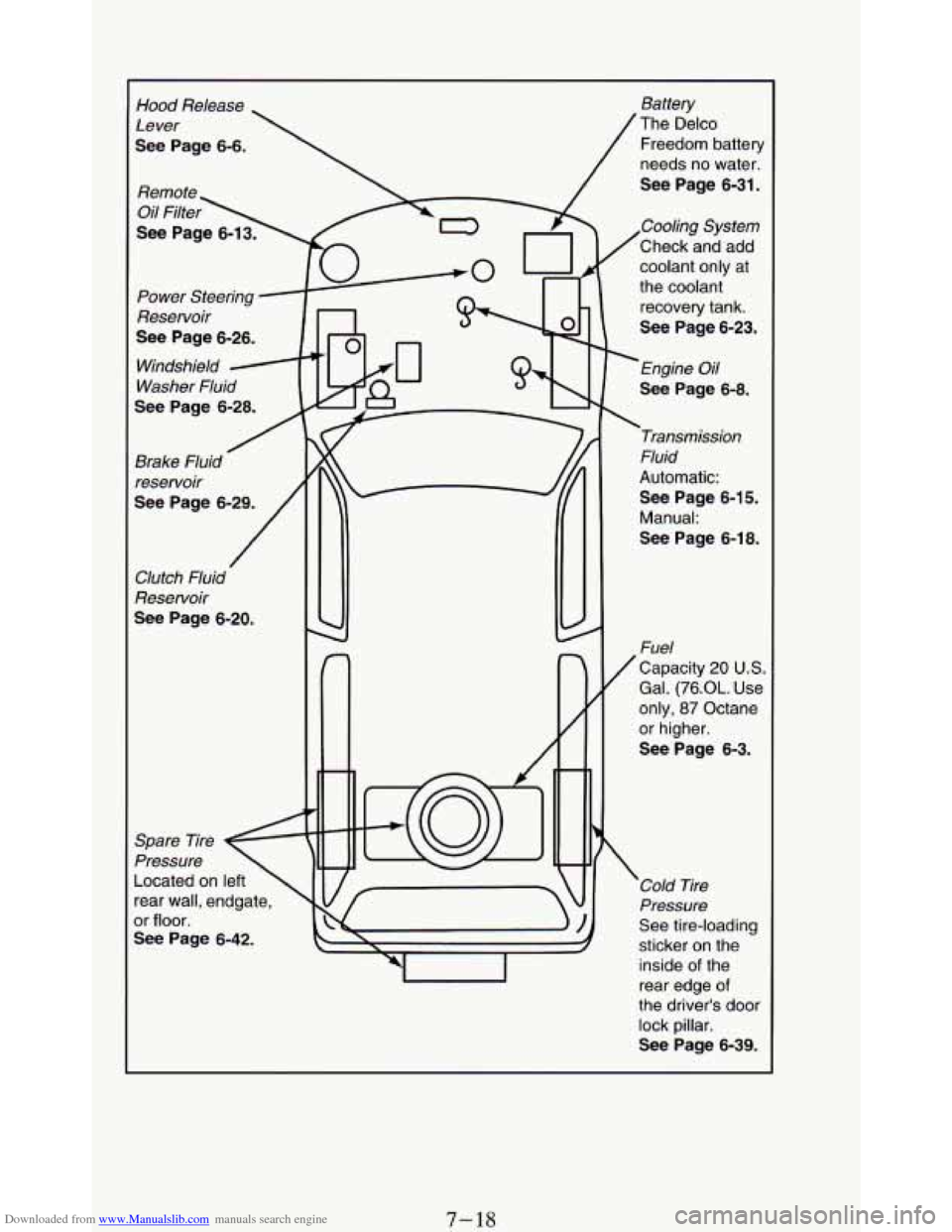
Downloaded from www.Manualslib.com manuals search engine Hood Release
Lever
See Page 6-6.
Remote
Oil Filter
See Page 6-13.
Power Steering
Reservoir
See Page 6-26.
Windshield -
Washer Fluid
See Page 6-28.
/ Brake Fluid
reservoir
See Page 6-29.
/
Clutch Fluid -
Reservoir
See Page 6-20.
Spare Tire
Pressure
Located on left
rear wall, endgat
3r floor.
See Page 6-42.
Battery
The Delco
Freedom battery
needs no water.
See Page 6-31.
,Cooling System
Check and add
coolant
only at
the coolant recovery tank.
See Page 6-23.
Engine Oil
See Page 6-8.
Transmission
Fluid
Automatic:
See Page 6-15.
Manual:
See Page 6-18.
/ Zacity 20 U.S.
Gal. (76.0L. Use
only, 87 Octane
or higher.
See Page 6-3.
Cold Tire
Pressure
See tire-loading
sticker
on the
inside
of the
rear edge
of
the driver's door
lock pillar.
See Page 6-39.
7-18